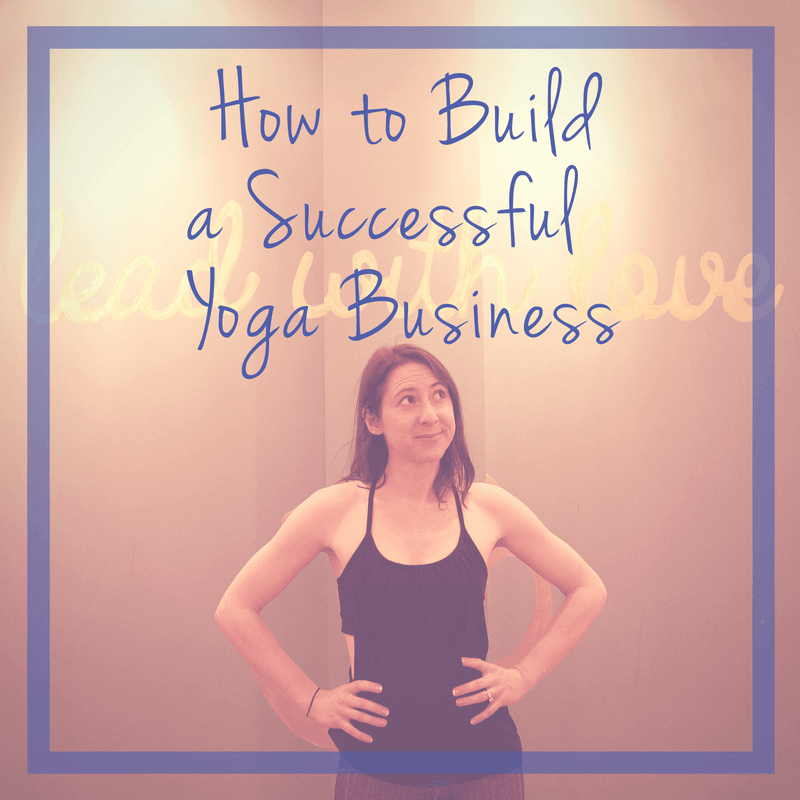
When I first decided to make a go of teaching yoga full time, I quickly realized I wasn’t in the right place and it wasn’t the right time in my life. I plowed ahead as a part-time teacher instead, gaining as much experience as I could while also putting my marketing skills to work for a friend and mentor, Charlie Gilkey. During my time working for Charlie, he wrote and published The Small Business Lifecycle, a guide for small business owners navigating the different stages of running and growing a business.
I have since returned to teaching yoga full time, and have found value in translating Charlie’s ideas to the independent yoga business model.
Yoga professionals operate in a funny place where it’s possible to have a successful teaching “career” without a real business. As long as you have charm, are willing to hustle hard, and know the right people, you can teach enough classes, lead enough workshops, and maybe even plan some retreats and make enough to get by.
The problem is, you don’t really have a business if all your income comes from teaching at and for yoga studios. You have a few part-time jobs, perhaps at a few different places, but you don’t have a business. When the yoga studio you have relied on for so long closes, changes ownership, or a relationship goes sour, your entire income plan gets shattered. This is why it’s important to have your own independent yoga business. When you are your own boss, you don’t rely completely on others to sustain your lifestyle. You create your own fortune. However, it’s next to impossible to sustain the independent yoga business model long-term without gaining real business chops along the way.
Read the different stages of the independent yoga business below and see if you can determine what stage you’re in right now. This outline is meant to be a summary and doesn’t provide detailed analysis on what to do in each stage. Stay tuned for more of my thoughts on each step coming soon.
**Note: This is meant to outline the stages of an independent yoga business rather than a traditional yoga studio business model**
Step 1: Dream
So you want to be a yoga teacher?
Well, you’ve got to start somewhere. You’ll probably start sitting at your desk, reading this blog post, avoiding the work you have to do at your day-job before you can hit the studio after work for your near-daily yoga class.
At the beginning, all we can do is dream.
It may be that you really don’t like your current career or that you just flat-out love yoga. You just graduated yoga teacher training or are about to soon and you can’t wait to get out there and start putting into practice all that you have learned.
So what can you do when you haven’t even started yet? You can start.
Start thinking about (and maybe even writing down) answers to the following questions. These answers will come in handy down the road and inform how you (hopefully) go about building your independent yoga business.
- Why do you want to teach yoga?
- Who do you want to teach yoga to?
- Where do you want to teach?
- When do you want to teach?
- How do you want to teach?
- How are you going to make money?
- How much money do you need to make to survive?
- What area of focus do you want to address through your yoga teaching? (therapeutic, building strength, gentle and restorative, meditation, etc.)
Step 2: Say yes
After you’ve taught your first class, you’ll feel as exhilarated and on-top-of-the-world as it gets. Bottle up that enthusiasm and put it to work!
Now is the time to take all opportunities that come your way and to actively pursue opportunity. Don’t expect that just because you are now a certified yoga teacher that you’ll automatically be handed a job teaching. As in all industries, you’ll have to work for it.
The reality is that when you’re just starting out you’ll be offered all the crappy class slots — take them anyway! This is your ticket to more teaching experience and you need teaching experience to build credibility, relationships, and opportunities down the road.
Look outside the yoga studio for opportunities as well. Teach at your gym, at your workplace, at a community center. It’s best to set aside your pretensions about the ideal teaching environment and be willing to get your feet dirty. Teach your friends, your parents, their friends. Anyone who is willing, teach!
Don’t forget to take notes. This is your time to find your voice and test what works for your students and what doesn’t. It’s also a time to test what works for you and what doesn’t. You may find out you don’t like teaching at gyms or in studios or that you don’t like teaching group classes at all! You might find that the area of focus you thought you wanted to stick to doesn’t actually bring you joy. This is all good information for later.
Your only job in this stage is to take advantage of opportunities and start figuring out what feels like the right fit.
Over time, you’ll start developing your niche, which will help you move forward into the next stage of your independent yoga business.
Step 3: Watch out for burnout!
At this point, you’ve probably contemplated leaving your day-job, if you haven’t already. You feel like you’re teaching yoga full time even though you have another job helping to pay the bills. You’ve got a full class schedule, private clients, and workshops booked.
But you’re running into a couple problems:
- You just don’t have enough time!
- You feel like you’ve been working really hard and have as full a schedule as you can have, but you don’t quite have the class numbers you want, the income you want, the clients you want, the email list size you want. You’re getting there, but you’re definitely not “there.”
Now is the time to really home in on your niche. All the opportunities that you took in the last stage need to get trimmed to meet your specific strengths and desires as a teacher. If you choose to teach gentle and restorative classes only, you don’t need that vinyasa class on your schedule anymore.
The more you can focus on your niche in this stage, the less you’ll face serious burnout. Alas, none of us can escape it but we can refuel our passions by staying committed to what keeps our fires burning!
That includes your personal practice.
This is the stage you’re most likely to lose sight of your personal practice. It’s time to recommit to your own growth and development. Healer, heal thyself.
Step 4: The transition
This is the stage where you will transition from a yoga teacher to a yoga professional. It’s no longer going to work to do this on your own. You need help if you want to keep going and stay afloat.
It’s also no longer good enough to not have a plan. You need a solid business foundation to sustain growth and, unfortunately, this is where many yoga professionals who make it this far get hung up.
At this point you have a very full schedule. You teach too many weekly classes and you know it’s not sustainable for your body and mind to keep going at this pace. At the same time, you’re invested in your communities and you don’t want to leave them behind.
You’ve done A LOT of work to get to this point and it feels scary to make any sudden moves that will disrupt the tenuous and strange equilibrium you think you have achieved. But you’re also downright exhausted.
Besides not having any time to focus on the foundational pieces of your business, you still feel like you’re not quite yet making enough money to get by.
In The Small Business Lifecycle, Charlie argues that the things you need to succeed in this stage of business include people, systems, and processes. The hard part about this truth is that people and systems cost money. If there is one thing that makes independent yoga businesses more imbalanced compared to other businesses, it’s probably the amount of hustle we put in for so little return. Many of us find that we reach this stage of business and yet don’t have enough money to make the investments needed to find and pay the people and systems that will help us move forward.
And that, frankly, sucks.
In my opinion, the way forward for the yoga professional is to first take some big steps back. We’ve done the work to gain some notoriety amongst our students and in our communities. Now it’s time to go back to look at how we can really move forward strategically.
I think it’s necessary that we do struggle in all the previous stages — we all have to pay our dues and work our way up from the bottom. We need the teaching experience to refine our teaching skills, find our voice, and discover our true passion and reason for being on this Earth to share the practices of yoga.
Once we have become experienced and we have a built-in fan base, now we can really start to move quickly in the right direction. We just have to know which direction is the right one.
This is undoubtedly the most uncomfortable stage because it will force us to ask deep questions of ourselves. It is impossible to move past this stage successfully without doing inner work. This stage of business is kind of like a built-in yoga-proofing mechanism that beautifully aligns with something Patanjali points out in the Yoga Sutra.
Sutra 3.52: “When tempted by the invisible beings in high places let the yogi feel neither allured nor flattered; for he is in danger of being caught once more by ignorance.”
-Prabhavananda
This sutra warns against feeling puffed-up and important based on the praise of others. Although the original intention of “invisible beings in high places” referred to gods or angels, we can extrapolate that phrase today to also refer to people in our industry who are influential and farther along the path than us. It’s easy to get caught up in the orbits of our networks, the feedback from our students, and the influence of our mentors; however, if we resist doing the tough inner work in this stage of business, the likelihood of spinning out of control and falling from grace later on becomes much higher.
It’s not just our business that must transition in this phase of the cycle, it’s our Self, our mindset, and our relationship to business as a whole.
Some practical considerations for this stage of business include:
- Simplicity
- Optimization
- Clarity
- Sustainability
- Relationships
Step 5: Karma Yoga
If there is one factor more motivating than all the rest for us yoga professionals, it may be this.
Once we figure this whole business thing out, we can dedicate more of our efforts toward service.
It’s hard to dedicate your life to the causes you want to support when you can’t even support yourself and your family.
If you get that taken care of, the rest can become all about giving back.
And yogis love nothing more than giving back.
So if there is one reason to make it past all the tough inner work in the last stage, it’s so you can reach this stage of your independent yoga business and truly serve.
At this point, your biggest problems are the distractions that will come your way. Now that you are well known and credible, everyone will want to leverage and benefit from the notoriety and support you have built for yourself.
The good news is you have already proven you are capable of solving any problem that may come your way and you have the team in place to help you navigate through distractions.
Now is the time to start focusing on your legacy. What do you want to be remembered for sharing and teaching?
Are you creating something that will last well after you are gone?
Conveniently or inconveniently, however you choose to view it, focusing on your legacy project often knocks you back down a few stages as you start figuring things out all over again 😁
The wheel
Like the chakras, this model is not meant to be linear. Our life journeys aren’t linear, so why would we expect our business journey to be?
There is no set amount of time I can give you for each stage – it’s completely unique to your business and situation, just like yoga practice is unique to each individual.
I read a quote once that I wrote down but can never remember who said it. (If you’re reading this, let me know so I can give you credit!) The woman was a business owner herself and she said:
“Business is a path of soul growth.”
I couldn’t agree more.





